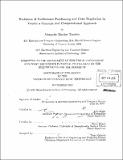Evolution of nucleosome positioning and gene regulation in yeasts : a genomic and computational approach
Author(s)
Tsankov, Alex
DownloadFull printable version (12.11Mb)
Other Contributors
Massachusetts Institute of Technology. Dept. of Electrical Engineering and Computer Science.
Advisor
Aviv Regev and Oliver Rando.
Terms of use
Metadata
Show full item recordAbstract
Chromatin organization plays a major role in gene regulation and can affect the function and evolution of new transcriptional programs. Here, we present the first multi-species comparative genomic analysis of the relationship between chromatin organization and gene expression by measuring mRNA abundance and nucleosome positions genome-wide in 13 Ascomycota yeast species. Our work introduces a host of new computational tools for studying chromatin structure, function, and evolution. We improved on existing methods for detecting nucleosome positions and developed a new approach for identifying nucleosome-free regions (NFRs) and characterizing chromatin organization at gene promoters. We used a general statistical approach for studying the evolution of chromatin and gene regulation at a functional level. We also introduced a new technique for discovering the DNA binding motifs of transacting General Regulatory Factors (GRFs) and developed a new technique for quantifying the relative contribution of intrinsic sequence, GRFs, and transcription to establishing NFRs. And finally, we built a computational framework to quantify the evolutionary interplay between nucleosome positions, transcription factor binding sites, and gene expression. Through our analysis, we found large conservation of global and functional chromatin organization. Chromatin organization has also substantially diverged in both global quantitative features and in functional groups of genes. We find that global usage of intrinsic anti-nucleosomal sequences such as PolyA varies over this phylogeny, and uncover that PolyG tracts also intrinsically repel nucleosomes. The specific sequences bound by GRFs are also highly plastic; we experimentally validate an evolutionary handover from Cbfl in pre-WGD yeasts to Rebi in post-WGD yeast. We also identify five mechanisms that couple chromatin organization to evolution of gene regulation, including (i) compensatory evolution of alternative modifiers associated with conserved chromatin organization; (ii) a gradual transition from constitutive to transregulated NFRs; (iii) a loss of intrinsic anti-nucleosomal sequences accompanying changes in chromatin organization and gene expression, (iv) repositioning of motifs from NFRs to nucleosome-occluded regions; and (v) the expanded use of NFRs by paralogous activator-repressor pairs. Our multi-species dataset and general computational framework provide a foundation for future studies on how chromatin structure changes over time and in evolution.
Description
Thesis (Ph. D.)--Massachusetts Institute of Technology, Dept. of Electrical Engineering and Computer Science, 2010. Cataloged from PDF version of thesis. Includes bibliographical references (p. 107-111).
Date issued
2010Department
Massachusetts Institute of Technology. Department of Electrical Engineering and Computer SciencePublisher
Massachusetts Institute of Technology
Keywords
Electrical Engineering and Computer Science.